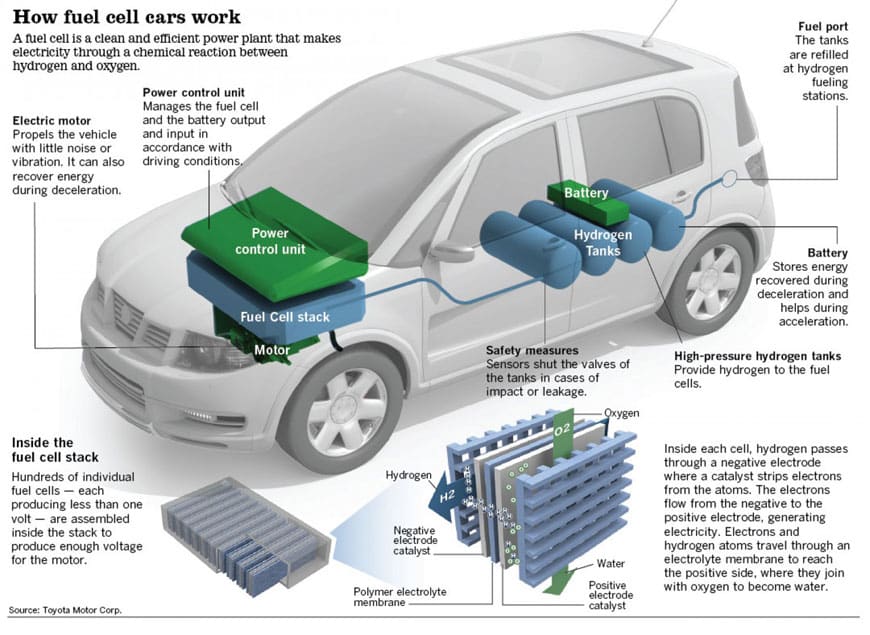Imagine a world filled with vehicles that only emitted water vapor. Pollution would likely be at an all-time low and the need for fossil fuels would be a drastically decreased, potentially creating a better world for everyone.
But in reality there are only about 250 hydrogen fuel cell vehicles in the entire state of California, and not many more throughout the country. The fuel cell has yet to take off as an alternative energy source and there are plenty of reasons why.
Batteries vs. Hydrogen
The Toyata Prius, Tesla S, and Chevy Volt are some of the most popular battery and hybrid powered cars on the market. Hybrid and totally battery-powered vehicles are far and away the easiest way for automakers to produce energy efficient options.
Batteries have been a main source of electrical energy since the early 1800’s, and provide a cheaper and more established option for vehicle power. They are easy to use, sustainable, and clean. However, the mileage range is low, charge time is long, and parts are expensive to replace.
With the hydrogen fuel cell, the mileage range is on par with current gas-powered vehicles. Hydrogen is the most common element in the world and makes up 75% of normal matter, but needs to be converted into a liquid to be used as fuel.
The battle between hydrogen and batteries will continue to be fierce, but the fuel cell is far and away the more efficient, albeit more expensive, option.
Established Fuel Cell Technology
Plenty of the big name automakers have spoken of their desire to make the hydrogen fuel cell a bigger option.
“Today, Toyota actually favors fuel cells over other zero-emission vehicles, like pure battery electric vehicles,” Craig Scott, Toyota’s national manager of advanced technologies tells the LA Times. “We would like to be still selling cars when there’s no more gas. And no one is coming to our door asking us to build a new electric car.”
The technology has been available, and even already put into practice with trial lease options.
Hyundai is the first manufacturer to release a fuel cell powered car to the public market with the Tucson Fuel Cell. The car is only being leased in Southern California and is set at $499 a month for three years after a $2,999 down payment.
The only problem is the lack of fueling stations, which are almost exclusively located in California.
The Cost
For gas station owners the cost of implementing a hydrogen pump is massive. The energy commission and air quality district in Southern California has spent $11.4 million on building, operating, and maintaining nine stations alone.
Typically, the cost to install a hydrogen pump ranges from $500,000 to $5 million, and without the cars on the road it isn’t worth the money.
The high cost is all carried over in the vehicles themselves, with Toyota setting its launch price in Japan at $68,000.
Even with the typical government rebate for buying a zero-emission vehicle, the cost is still too high on both sides of the market. Hydrogen pumps won’t be available without hydrogen cars on the road, and with unreasonable price options, these cars won’t sell.
But can the fuel cell become something big once the technology becomes more available to help drop prices?
The Fuel Cell Benefits and How They Work
Fully-powered battery cars currently have a limited range, and hybrids still require gasoline. The hydrogen fuel cell allows a vehicle to operate with no toxic emissions while being powered by the most abundant element on the planet.
Fuel cells convert liquid hydrogen into electricity, which in turn powers a car. There is a lot of chemistry going on inside a very small box. The process is extremely complicated, but the outcome is a car that can travel distances drivers are accustomed to, without the byproducts of fossil fuels.
If the auto industry needs to resort to a fuel option that doesn’t deplete the earth’s already dwindling resources, hydrogen is easily the best option.
Carmakers have been working diligently at creating viable fuel cell powered vehicles. They will be here sooner than we think.
Availability
As soon as 2015, there will be hydrogen-powered vehicles ready for the public. Honda’s FCEV concept is expected to launch in both the U.S. and Japan sometime next year, while Toyota is releasing its own FCV (Fuel Cell Vehicle) by the middle of 2015.
According to Toyota’s environmental communications manager Jana Hartline, the FCV has been “optimized for comfort.”
“We aren’t quite ready to show off the interior yet, but it’s safe to say that it’ll be very spacious with ample trunk room.”
As far as fueling stations are concerned, there are currently only 52 public and private hydrogen stations in the entire country – 21 of which are in California.
Will They Work?
The lack of fuel pumps and the cost per vehicle are the only problems that will hold this technology back from being a viable option.
Current hybrids like the 2015 Toyota Prius start at $24,200, while a 2015 Honda Insight starts at only $18,725.
With plenty of much cheaper options in hybrid and electric vehicles, the fuel cell doesn’t look like it can compete until the technology becomes less expensive. But when it does, the fuel cell will be the best zero-emission option by a landslide.



